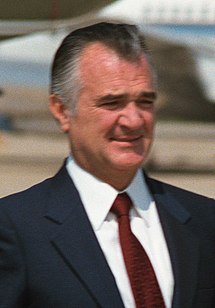Miguel de la Madrid: Difference between revisions
Wendie 1970 (talk | contribs) |
m →External links: Bot Replacing "Refernce" with "References" or "External link" with "External links" in headers (Trial), replaced: ==External link== → ==External links== |
||
| Line 55: | Line 55: | ||
{{end box}} |
{{end box}} |
||
==External |
==External links== |
||
* [http://www.cidob.org/es/documentacion/biografias_lideres_politicos/america_del_norte/mexico/miguel_de_la_madrid_hurtado Biography by CIDOB] (in Spanish) |
* [http://www.cidob.org/es/documentacion/biografias_lideres_politicos/america_del_norte/mexico/miguel_de_la_madrid_hurtado Biography by CIDOB] (in Spanish) |
||
Revision as of 21:42, 5 July 2012
Miguel de la Madrid | |
|---|---|
 | |
| 52nd President of Mexico | |
| In office December 1, 1982 – November 30, 1988 | |
| Preceded by | José López Portillo |
| Succeeded by | Carlos Salinas |
| Personal details | |
| Born | December 12, 1934[1] Colima, Mexico |
| Died | April 1, 2012 (aged 77) Mexico City, Mexico |
| Political party | Institutional Revolutionary Party |
| Spouse | Paloma Cordero Tapia[2] |
Miguel de la Madrid Hurtado (December 12, 1934 – April 1, 2012) was a Mexican politician affiliated to the Institutional Revolutionary Party (PRI) who served as 52nd President of Mexico from 1982 to 1988.[1]
Biography
Miguel de la Madrid graduated with a bachelor's degree in Law from the National Autonomous University of Mexico (UNAM) and received a master's degree in Public Administration from the John F. Kennedy School of Government at Harvard University, in the United States.[1]
He worked for Mexico's central bank and lectured in law at UNAM before securing a position at the Secretariat of Finance in 1965. Between 1970 and 1972 he was employed by [Petróleos Mexicanos] Error: {{Lang}}: text has italic markup (help), Mexico's state-owned petroleum company, after which he held several other bureaucratic posts in the government of Luis Echeverría. In 1976 he was chosen to serve in José López Portillo's cabinet as secretary of budget and planning.[1]
He was president after López Portillo. He won the elections that took place on 4 July 1982, and took office the following December.
He was a member of Collegium International, an organization of leaders with political, scientific, and ethical expertise whose goal is to provide new approaches in overcoming the obstacles in the way of a peaceful, socially just and an economically sustainable world.[citation needed]
Mexican presidency

Unlike previous Mexican leaders, he was a market-oriented President, and his time in power was one of the most difficult periods of the country because of his predecessors' policies, as well as the decreasing demand for oil. Inflation increased on an average of 100% a year (culminating to an unprecedented level of 159% in 1987), unemployment rates soared to as much as 25% during the mid-1980s, income declined and economic growth was erratic. This became a stark reminder of the gross mismanagement and inept policies of the administrations in the 1970s, particularly the financing of development with excessive borrowing from abroad.[3]
During de la Madrid's presidency, he introduced liberal economic reforms that encouraged foreign investment, and widespread privatisations of outdated state-run industries and reduction of tariffs, a process that continued under his successors, which immediately caught the attention of the International Monetary Fund (IMF) and other international observers. In 1986, Mexico entered the General Agreement on Tariffs and Trade (GATT) treaty, following its efforts of reforming and decentralising its economy. All told, the number of state-owned industries went down from approx. 1,155 in 1982 to 412 in 1988. This was enough to bring him some strong support, but his administration's mishandling of the infamous 1985 earthquake in Mexico City damaged his popularity for initially refusing international aid, and it placed Mexico's delicate path to economic recovery in an even more precarious situation, as the destruction also extended to other parts of the country.[2]
Galloping inflation, the controversial privatisation programme and austerity measures imposed by his administration caused the ruling party to lose ground, leading up to the controversial elections of 1988.
Death
De la Madrid died on 1 April 2012, apparently following a lengthy hospitalization for complicated Chronic Obstructive Pulmonary Disease, which led to acute renal failure and cardiac arrest.[4]
See also
References
- ^ a b c d Encyclopædia Britannica (2008). "Miguel de la Madrid". Encyclopædia Britannica Online. Retrieved 1 July 2008.
- ^ a b Ortiz de Zárate, Roberto (10 May 2007). "Miguel de la Madrid Hurtado" (in Spanish). Fundació CIDOB. Retrieved 1 July 2008.
- ^ Duncan, Richard (21 June 2005). "An Interview with Miguel de la Madrid". Time. Retrieved 1 July 2008.
{{cite journal}}: Unknown parameter|coauthors=ignored (|author=suggested) (help) - ^ http://www.milenio.com/cdb/doc/impreso/9139921
External links
- Biography by CIDOB (in Spanish)
- Presidents of Mexico
- Mexican presidential candidates (1982)
- Institutional Revolutionary Party politicians
- Mexican lawyers
- National Autonomous University of Mexico alumni
- National Autonomous University of Mexico faculty
- John F. Kennedy School of Government alumni
- People from Colima, Colima
- 1934 births
- 2012 deaths

